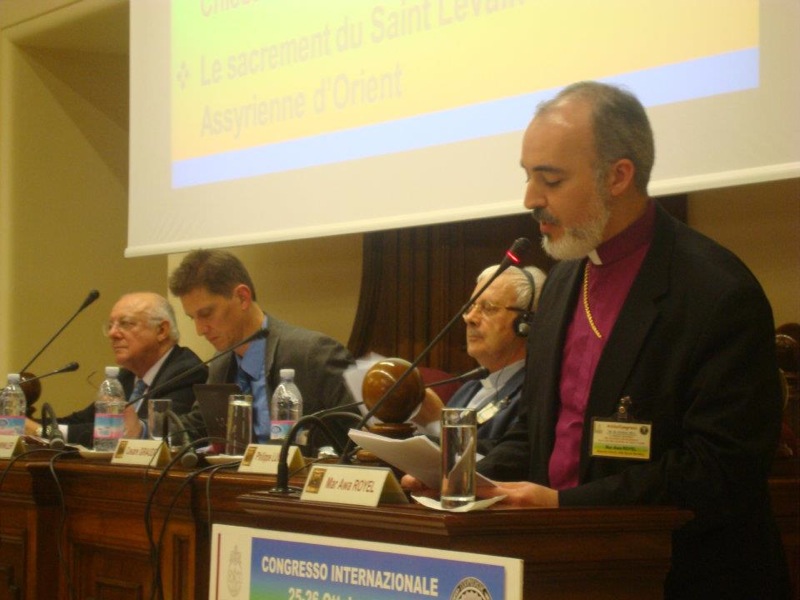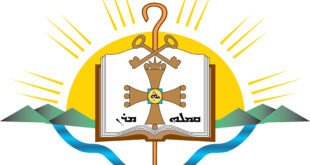His Beatitude Mar Aprem, Metropolitan of Malabar and India and the United Arab Emirates, His Grace Mar Awa Royel, Bishop of California and Secretary of the Holy Synod, and Rev. William Toma of the Diocese of Eastern USA participated in the International Congress on the Anaphora of Addai and Mari, held in Rome on 25 and 26 October 2011.
Under the theme: ‘The Genesis of the Anaphoral Institution Narrative in Light of the Anaphora of Addai and Mari’, the Congress was jointly organised by the Pontifical Oriental Institute and the Pontifical Gregorian University in Rome.
The first day of Congress proceedings were devoted to reflection through historical and canonical lectures on the Assyrian Church of the East, the Chaldean Catholic Church and the Syro-Malabar Catholic Church which all use the Anaphora of Addai and Mari in their liturgical life, though the latter two Churches have greatly changed the original text of this most ancient anaphora. The Congress’ second day was devoted to lectures bringing to light the origins of the Institution Narrative of the eucharistic prayer, with specific reference to the Anaphora of Addai and Mari, and analogous instances, especially of the Syriac, Maronite and Ethiopian anaphoric traditions.
His Beatitude Mar Aprem Metropolitan presented a paper titled: ‘The Assyrian Church of the East Throughout History’ on 25 October. His Grace Bishop Mar Awa’s paper, ‘The Mystery of the Holy Leaven (Malka) in the Assyrian Church of the East’ was delivered the following day. Other participants in the International Congress included eminent Syriac Studies scholars and representatives of the Roman Catholic and Oriental Orthodox Churches.
The Anaphora of Addai and Mari is one of the world’s most ancient liturgies and has been in continuous use by the Church of the East since the apostolic age, and is the most ancient still in usage in all Christendom. This particular anaphora, one of three used by the Assyrian Church of the East, is used from Palm Sunday until the end of the liturgical year, covering almost 200 days.
The Congress commemorated the 10th anniversary of a lengthy period of dialogue between the Assyrian Church of the East and the Roman Catholic Church regarding the validity of the Anaphora of Addai and Mari, which does not contain an Institution Narrative. On 17 January 2001, the Congregation for the Doctrine of the Faith recognised the validity of the Eucharist celebrated within the Anaphora of Addai and Mari without an ‘Institution Narrative’.
This decision, approved in advance by the late His Holiness Pope John Paul II was made public inL’Osservatore Romano on 26 October 2001 in a document titled: Guidelines for Admission to the Eucharist between the Chaldean Church and the Assyrian Church of the East.
This agreement provides for the admission to the Eucharist between the Chaldean Church and the Assyrian Church of the East in situations of pastoral necessity and was published with the agreement of the Holy Synod of the Assyrian Church of the East, the Pontifical Council for Promoting Christian Unity, the Congregation for the Doctrine of the Faith and the Congregation for the Oriental Churches.
The latter document notes that “… the Anaphora of Addai and Mari is one of the most ancient anaphoras, dating back to the time of the very early Church; it was composed and used with the clear intention of celebrating the Eucharist in full continuity with the Last Supper and according to the intention of the Church …”
The document also notes that: “… the Catholic Church recognises the Assyrian Church of the East as a true particular Church, built upon orthodox faith and apostolic succession. The Assyrian Church of the East has also preserved full Eucharistic faith in the presence of our Lord under the species of bread and wine and in the sacrificial character of the Eucharist.”
The guidelines go on to note that, “the words of Eucharistic Institution are indeed present in the Anaphora of Addai and Mari, not in a coherent narrative way and ad litteram, but rather in a dispersed euchological way, that is, integrated in successive prayers of thanksgiving, praise and intercession.”
As a result of these 2001 guidelines, and the Common Christological Declaration signed in 1994 by the late His Holiness Pope John Paul II and His Holiness Mar Dinkha IV, Catholicos-Patriarch of the Assyrian Church of the East, the main dogmatic dispute between the Catholic Church and the Assyrian Church of the East had been resolved.
The signing of these documents, along with the many years of work done by the Joint Committee for Theological Dialogue between the Catholic Church and the Assyrian Church of the East are important milestones in the ecumenical rapprochement between the two venerable Sister-Churches, and they pave the way for future dialogue and ecumenical relations.
The Assyrian Church of the East delegation will continue their sojourn in Rome and, at the invitation of His Holiness Pope Benedict XVI to His Holiness Mar Dinkha IV, Catholicos-Patriarch, will attend the Day of Prayer for Peace in Assisi on Thursday, October 27, 2011, representing His Holiness Mar Dinkha IV.
[nggallery id=307] Assyrian Church News Official News Site of the Holy Apostolic Catholic Assyrian Church of the East
Assyrian Church News Official News Site of the Holy Apostolic Catholic Assyrian Church of the East

